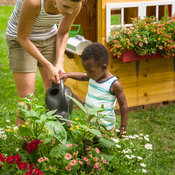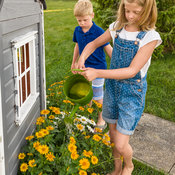How to Dry Out Overwatered Plants
Is your plant wilted even though the soil is wet? Is your plant light green and struggling? Well your problem might be over-watering. Read this article for tips on diagnosing an over-watering problem and then fixing it.
Did you know that over-watering is usually considered the most common cause of early plant death? In general, we are deathly afraid of under-watering our plants and as a result many of us tend to over-water. I am just as guilty of this as anyone else, although I am getting better. The best thing you can do to keep your plant healthy is to water it correctly.
 How do you know if your plant is drowning? First, have you been watering only when the surface of the soil is dry to the touch? If you haven’t, it is possible your plant is staying too wet. For more information on proper watering for plants in pots read “Water Your Way to Happy Plants.” Second, is your plant looking light green and generally unhappy? One possible reason for this is over-watering. While both of these foliage indicators are symptoms of over-watering, the most common way someone figures out their plant is drowning is that the plant has wilted even though the soil is wet.
How do you know if your plant is drowning? First, have you been watering only when the surface of the soil is dry to the touch? If you haven’t, it is possible your plant is staying too wet. For more information on proper watering for plants in pots read “Water Your Way to Happy Plants.” Second, is your plant looking light green and generally unhappy? One possible reason for this is over-watering. While both of these foliage indicators are symptoms of over-watering, the most common way someone figures out their plant is drowning is that the plant has wilted even though the soil is wet.
Why is over-watering so detrimental to plant health? Healthy roots are the foundation for healthy plants. Have you ever noticed that after you transplant a plant it will appear to sit there for a week or more before it starts growing? Well, it isn’t really just sitting there, it is establishing its root system. Once it has grown a substantial root system the plant starts putting its energy in growing a larger plant and more flowers.
Roots are important to a plant because they are its primary source of water and food and are also important for the uptake of oxygen. The roots of the plant take up water but they also need air to breathe. Over-watering, in simple terms, drowns your plant. Soil that is constantly wet won’t have enough air pockets and the roots can’t breathe. Roots that can’t breathe are stressed roots. Stressed humans are more prone to disease. Well, stressed plants are more prone to diseases too and one of the common forms of plant stress is unhealthy roots. Over-watered plants are likely to get root diseases, primarily root rot. You probably won’t know your plant has gotten root rot until you notice that it is wilted, but the soil is still wet.
What exactly is root rot? There are several different fungi that cause root rot. The most common culprits are Pythium, Phytopthera, and Rhizoctonia. Healthy roots should be white and clean looking. Roots with root rot are brown, grey, black, slimy or non-existent. Over-watering also tends to rob your plants of proper nutrition. Either the roots are damaged and can’t absorb the fertilizer in the soil or the excess water has leached the fertilizer from the soil. Either way the plant doesn’t have access to the food it needs.
OK, you’ve gotten this far and you think it is possible that you have been over-watering your plants. Now what? If the plants are showing some yellowing and you know they have been watered too much, but they haven’t started to wilt while wet, simply start following proper watering techniques (Click Here) and your plant should bounce back. Hold off on any application of fertilizer until you see new growth. Then I would fertilize with a water soluble fertilizer the next 2 to 3 times you water (after you see new growth) to increase the fertility level. After this go back to fertilizing every 7 to 10 days.
However, if your plant has jumped into the deep end even though it can’t swim (your plants are wilting even though the soil is still wet), then the plant is in much bigger trouble. If one plant in a combination planter is wilting and the others look fine you might want to consider removing the wilting plant to help keep the disease from spreading further. Begin using proper watering techniques (Click Here). If the whole planter is wilting you will have to be more aggressive.
CPR for Drowning Plants
- Move the planter to a shady area, even if it is a full sun plant. The roots of your plant are unable to take up enough water to keep your plant hydrated. Plants in shaded locations will use less water. Once the roots are healthy move sun plants back to a sunny location.
- Be sure the pot is draining. If no drainage holes exists add some or repot the plant into a pot with drainage holes. Do not allow the pot to sit in water, this will keep the soil too wet.
- If possible, create additional air spaces around the root ball. One way of doing this is slowly tilt the pot to its side and then gently tap the container, the soil ball should now be loose within the container. Carefully re-stand the pot up when completed there should be small air pockets between the pot wall and around the soil ball. This will allow the soil to dry quicker and at the same time bring oxygen to the root zone.
- If the plant isn’t too large, repot into a different pot. Be sure to add new soil. This will give the roots nice, clean soil to grow into. If the plant is too large to be easily repotted go on to number 5.
- Begin watering only when the surface of the soil is dry to the touch. Do not allow the plant to get extremely dry, this additional shock could be enough to kill the plant. If the plant is wilting badly, you can mist or syringe the plant’s foliage with water which will prevent too much leaf scorch. Do not fertilize. With the roots in a delicate state it can be easy to burn the roots with fertilizer. Once the plant resumes active growth return to normal fertilization.
- Treating with a broad-spectrum fungicide can be helpful. Your local garden center should be able to help you choose one.
- If the plant is going to make it you should begin to see improvement in a week or so. Once the plant seems to be growing nicely move it into a sunnier location and begin fertilizing again.
Even if you take all of these steps there is no guarantee that your plant will bounce back. It partially depends on how badly the roots have been damaged. If you have a tendency to kill a plant with kindness and are composting more than are surviving you might look at changing your soil mix to a lighter, fluffier soil. Make sure you have plenty of drainage holes in your containers. If all else fails grow plants that like their feet in water. Plants like Cyperus, Alocasia, Colocasia, Acorus, and many others will thrive in containers that drain slowly. If you tend to keep plants on the wet side you might want to steer clear of plants that are more prone to problems from over-watering than most other plants.
For more information on general watering practices read "Water Your Way to Happy Plants."
For more information on general watering practices read "Watering Container Plants."




